Wolfgang Puck BPCR0005 User Manual
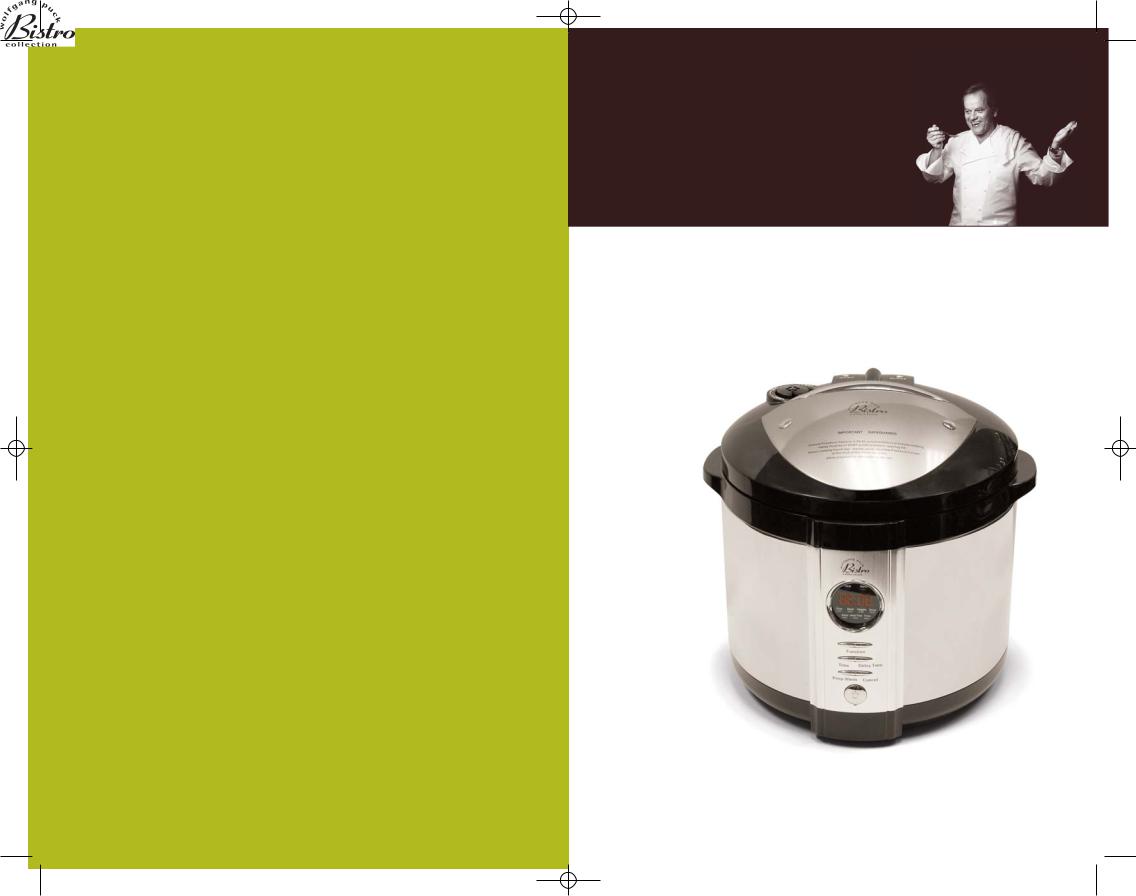
5QPressureCookerMan08 6/5/08 12:12 PM Page 1
I M P O R T A N T N O T I C E
PLEASE DO NOT RETURN TO STORE. If you have any problems with this unit, contact Consumer Relations for service PHONE: 1-800-275-8273 or
visit our website at wphousewares.com Please read operating instructions before using this product.
Please keep original box and packing materials in the event that service is required.
W.P. APPLIANCES, INC. Toll Free (800) 275-8273
Model BPCR0005 Printed in China REV 2.0
All trademarks, service marks and trade names (collectively the “Marks”) are proprietary to Wolfgang Puck World Wide.
Wolfgang Puck
Electric Pressure Cooker / Stockpot
Use and Care
1

5QPressureCookerMan08 6/5/08 12:12 PM Page 1
IMPORTANT SAFEGUARDS
When using pressure cookers, basic safety precautions should always be followed:
1Read all instructions carefully.
2 Do not touch hot surfaces. Use handles or knobs and a potholder. 3 Do not close or clog the safety valves under any circumstance.
4To protect against risk of electrical shock, do not put power cord, plug or body of the appliance in water or other liquid.
5Close supervision is necessary when any appliance is used by or near children.
6Unplug from outlet when not in use and before cleaning. Allow to
cool before putting on or taking off parts.
7Do not operate any appliance with a damaged cord or plug or
after the appliance malfunctions or is dropped or damaged in any manner. Return the appliance to an authorized service facility for examination, repair, or electrical or mechanical adjustment.
8Do not fill the unit over 2/3 full. When cooking foods that expand during cooking such as rice or dried vegetables, do not fill the unit
over 1/2 full. Over filling may cause a risk of clogging the vent pipe and developing excess pressure. See “Using Your Pressure Cooker” section of this manual.
9Be aware that certain foods, such as applesauce, cranberries,
pearl barley, oatmeal or other cereals, split peas, noodles, macaroni,
rhubarb, or spaghetti can foam, froth, and sputter, and clog the pressure release device (steam vent). These foods should not be cooked in a pressure cooker.
10The use of attachments not recommended or sold by the appliance manufacturer may cause fire, electric shock, or injury.
11Do not use outdoors.
12Do not place the appliance on or near hot gas or electric burners, or in a heated oven.
13Do not let cord hang over edge of table or counter or touch hot surfaces, including the stove.
14Extreme caution must be used when moving an appliance containing hot contents or liquids.
15This appliance cooks under pressure. Improper use may result in scalding injury. Make certain unit is properly closed before operating. See “Using Your Pressure Cooker” section of this manual.
16Do not use this appliance for other than intended use.
17To reduce the risk or electric shock, cook only in removable container.
18Always attach power cord to appliance first, and then plug cord into wall outlet. To disconnect, turn unit off, grasp plug, and pull from the wall. Never yank on cord.
19Always check the pressure release devices for clogging before use.
1
20Do not open the pressure cooker until has cooled and internal pressure has been released. If the lid is difficult to open, this indicates that the cooker is still pressurized - do not force it open. Any pressure in the cooker can be hazardous. See “Using Your Pressure Cooker” section of this manual.
21Do not operate this appliance in the presence of explosives and/or flammable fumes.
22Do not use pressure cooking for pressure frying with oil.
SAVE THESE INSTRUCTIONS
HOUSEHOLD USE ONLY
GROUNDING INSTRUCTIONS: This appliance must be grounded. It is equipped with a 3-prong cord having a grounded plug. The plug must be plugged into an outlet which is properly installed and grounded.
Warning: Improper use of the grounded cord can result in the risk of electric shock. Consult a qualified electrician if necessary. Do not attempt to defeat this safety feature by modifying plug.
A short power-supply cord is provided to reduce the hazards resulting from entanglement or tripping over a longer cord. If it is necessary to use an extension cord, it should be positioned such that it does not drape over the counter or tabletop where it can be pulled on by children or tripped over and:
A.Use only 3-prong extension cord with 3-blade grounding plug.
B.The marked rating of the extension cord must be equal to or greater then the rating of this appliance. The electrical rating is listed on the bottom of this unit.
Before Your First Use
Carefully unpack the pressure cooker and parts, and remove all packaging materials. Wash the removable cooking pot, lids and gasket in warm, soapy water to remove any dust that may have accumulated during packaging. Wipe cord and pressure cooker housing with a dry cloth. Do not immerse the cord or plug in water or other liquid.
Additional Safety Information
•Do not use the pressure cooker without liquid; this could damage the pressure cooker severely.
•Do not use pressure cooker for storage purposes nor insert any utensils.
2
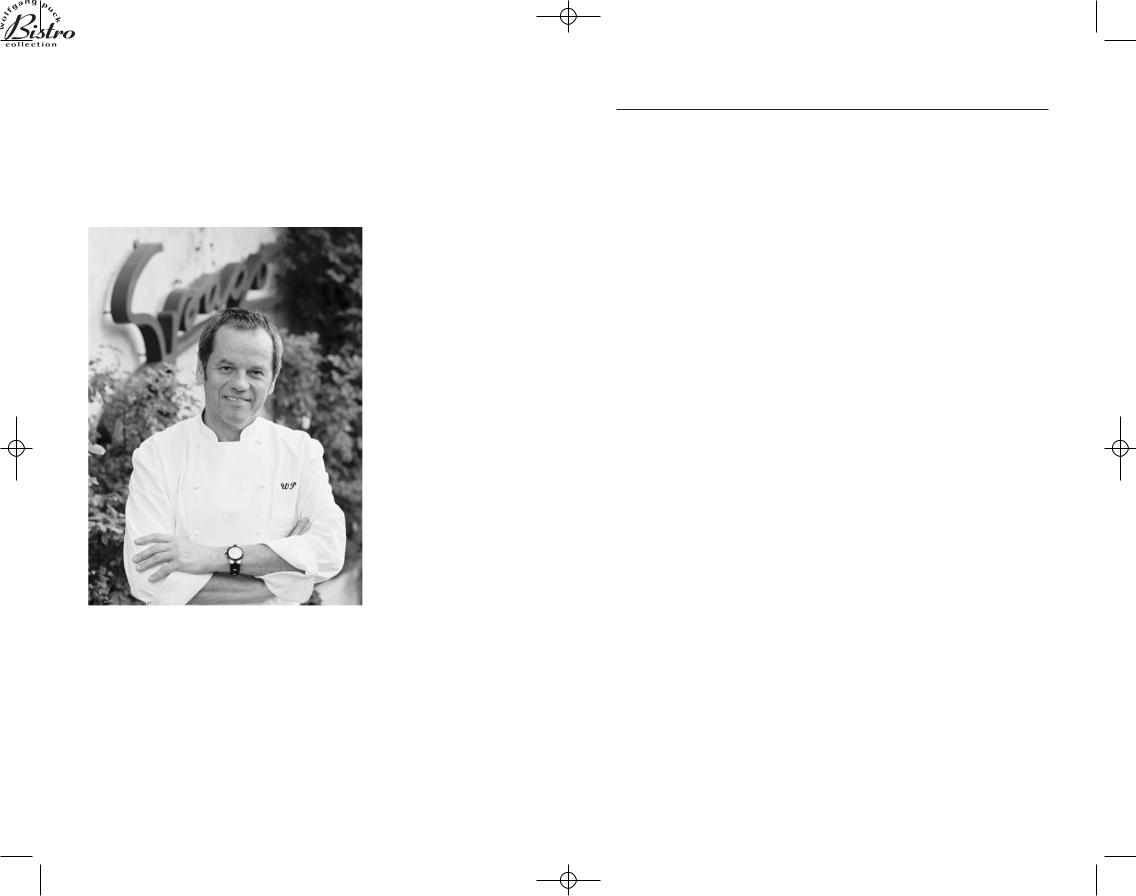
5QPressureCookerMan08 6/5/08 12:12 PM Page 3
Wolfgang Puck, owner of the famous Spago restaurants and one of the most influential chef-restauranteurs in America, is credited with reviving California’s rich culinary heritage. His cooking innovations,
a result of blending fresh California ingredients with his classical French techniques, are enjoyed by world leaders, stars and fellow chefs alike. He established other trend-setting restaurants like Postrio in San Francisco, Chinois on Main in Santa Monica, and Trattoria del Lupo, and his latest creation, Cut, a gourmet steakhouse in the Beverly Wilshire Hotel. Home chefs can also share Mr. Puck’s talents through his cookbooks and, of course, through his appliances!
Table of Contents
Important Safeguards |
|
1 |
Before Your First Use |
|
2 |
About Wolfgang Puck |
|
3 |
Know Your Electric Pressure Cooker |
5 |
|
Lid Assembly |
|
7 |
Pressure Cooker Settings |
|
8 |
About Pressure Cooking |
|
9 |
Additional Safety Tips |
|
9 |
Using Your Pressure Cooker |
|
10 |
Helpful Hints |
|
13 |
Care & Cleaning |
|
14 |
Recipes |
|
16 |
Pressure Cooker Cooking Chart |
57 |
|
Limited Warranty |
|
62 |
Contact Information |
back cover |
|
3
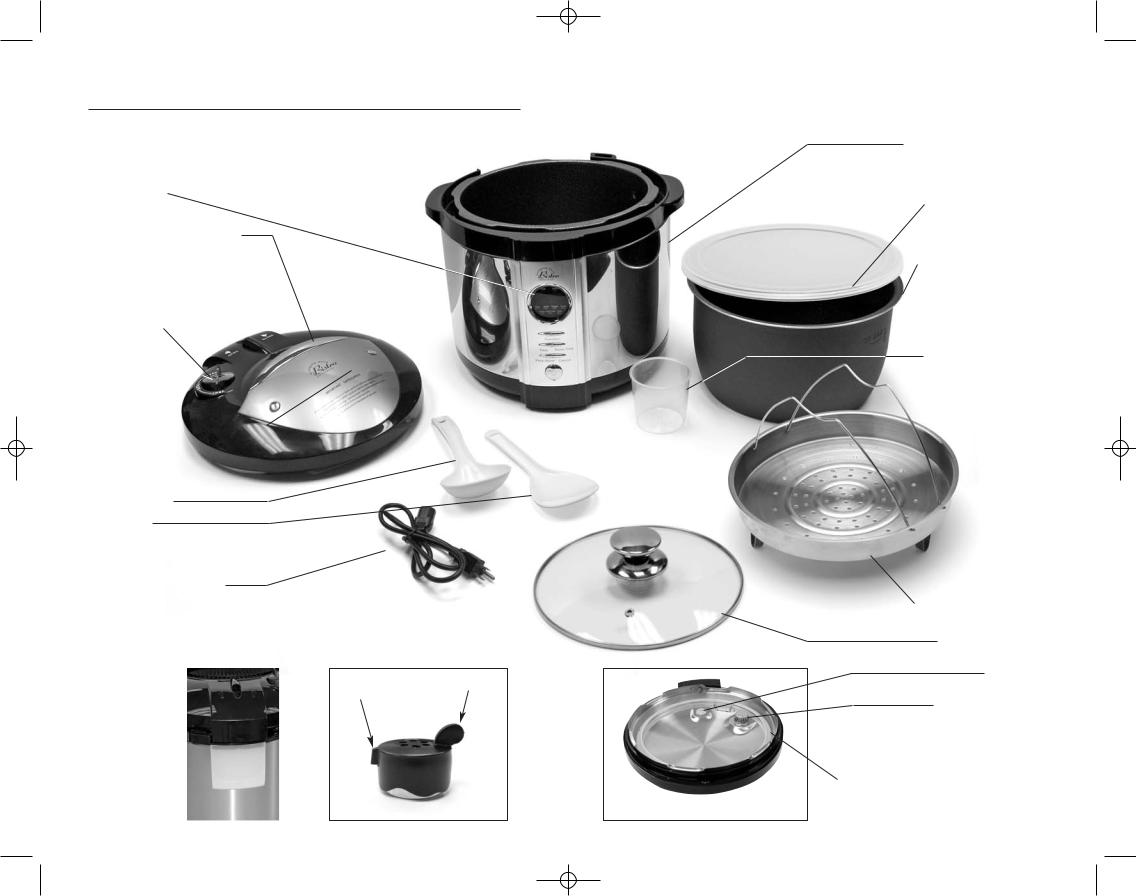
5QPressureCookerMan08 6/5/08 12:12 PM Page 5
Know Your
Electric Pressure Cooker
Control Panel
Pressure Cooker Lid Handle
Pressure Release Device
(Steam Vent)
Serving Spoon
Rice Scoop
Detachable Power Cord
Pointer |
Finger Grip |
Water Collector
(on back of appliance)
5 |
Underside of Cooker Lid |
6 |
Pressure Cooker Housing
Plastic Storage Lid for Removable Pot
Removable Cooking Pot
Rice Measuring Cup
Steaming/Cooking Rack
Tempered Glass Lid
Float Valve
Anti-Blockage Cover for Steam Release Valve
(prevents food particles from enterning valve)
Sealing Gasket
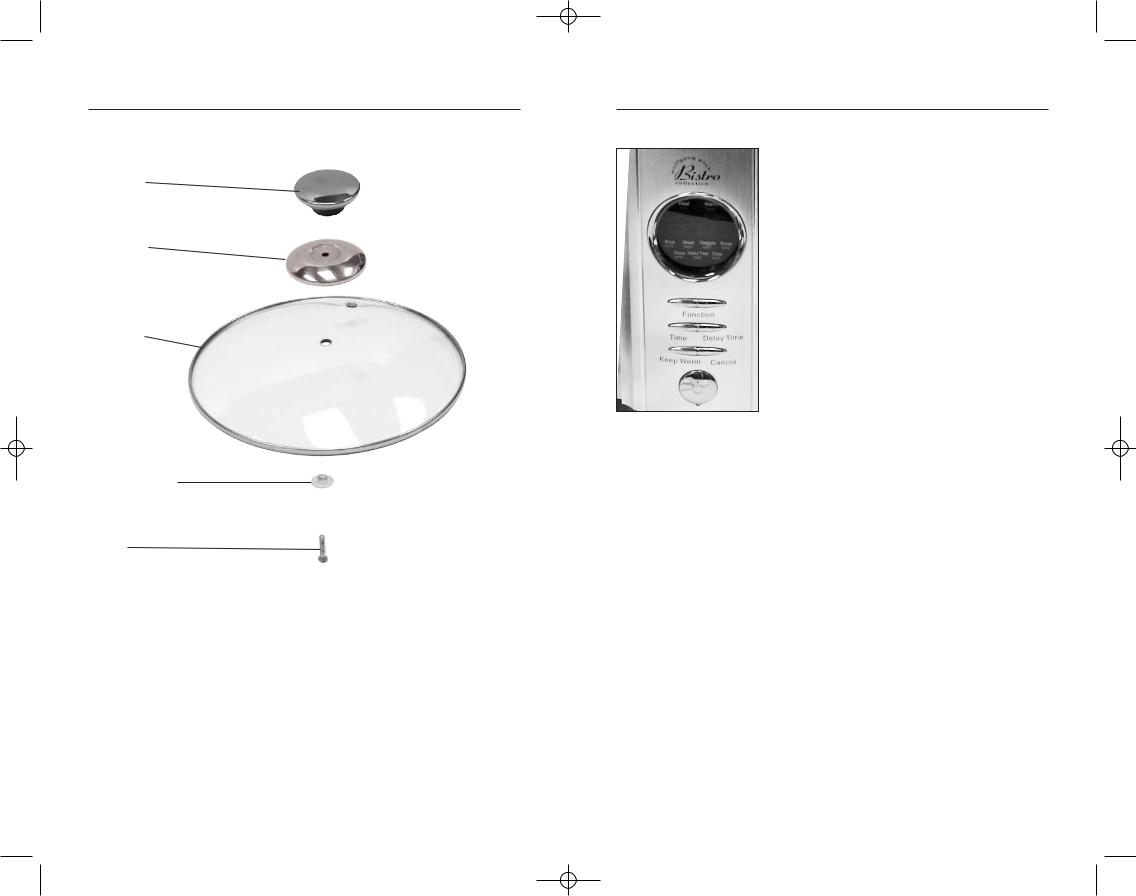
5QPressureCookerMan08 6/5/08 12:12 PM Page 7
Lid Assembly
Lid Knob
Lid Cover
Glass Lid
Silicon Washer
Washer 
Screw
For shipping purposes, the tempered glass lid must be assembled upon arrival. Please assemble as shown above. This lid is to be used when using cooker as a stockpot or when storing food in removable cooking pot.
Pressure Cooker Settings
TEMPERATURE INDICATOR LIGHTS
Heat |
Light indicates pressure cooker |
|
is heating to selected function |
Warm |
When the timer has expired, the |
|
pressure cooker automatically |
|
switches to Keep Warm |
|
temperature. The Warm indicator |
|
light will illuminate. |
FUNCTIONS
Your Wolfgang Puck Pressure Cooker has five preset cooking functions including specific temperature, pressure and times for each of the following selections. This takes all the guesswork out of pressure cooking for you! The preset cooking times are listed below:
Rice |
6 minutes |
Meat |
20 minutes |
Vegetable |
5 minutes |
Soup |
5 minutes |
Stew |
20 minutes |
Note: Timing will begin for each function once pressure is reached.
Delay Time |
Use to delay pressure cooking |
|
for up to 9 hours. |
Time |
Use to add cooking time to any |
|
preset function. |
Keep Warm/Cancel |
Press this button to stop |
|
cooking process and switch to |
|
Keep Warm mode. |
On/Off |
Press to Start or Cancel |
|
cooking process. |
7 |
8 |
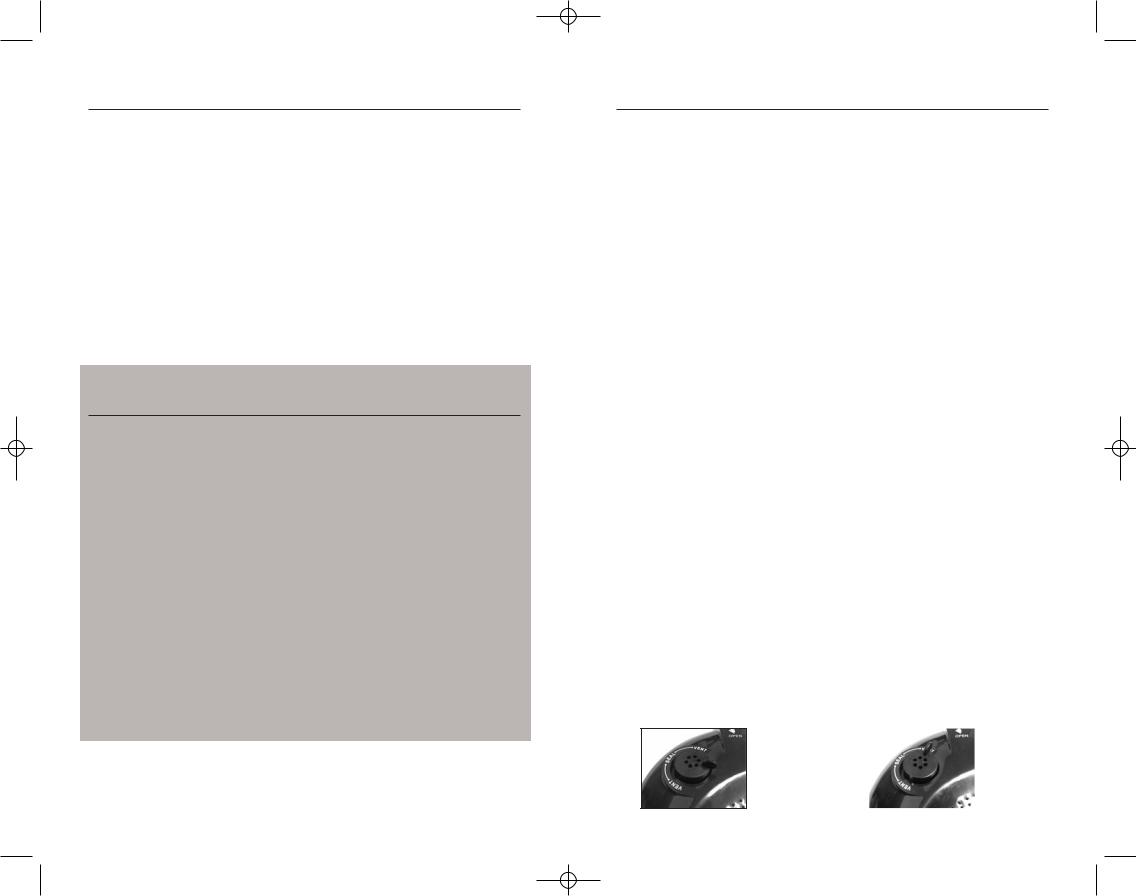
5QPressureCookerMan08 6/5/08 12:12 PM Page 9
About Pressure Cooking
Pressure cooking is an ideal way to make fast, tasty meals for your family! This method of cooking makes it easy for even the busiest cooks to prepare meals from scratch. Use your pressure cooker for fish, chicken, fresh vegetables, rice, legumes, and even dessert – and everything can be cooked to perfection in minutes. The pressure cooker will save you time, energy and money, as well as valuable nutrients. Boiling liquid inside the tightly sealed pot produces steam, which is trapped inside to create pressure. The very hot temperature produced reduces cooking time. The steam helps break down the fibers of whatever you’re cooking and infuse the food with flavors. This also captures all of the water-soluble nutrients, making the food higher in flavor and more nutritious than with conventional cooking methods.
Additional Safety Tips
•Always keep hands and face away from Pressure Release Device when reducing pressure.
•Use extreme caution when removing lid after cooking.
Always tilt the lid away from you, so any remaining steam is blocked from your face.
•Never attempt to open lid while cooking, or before pressure indicator has dropped. Do not attempt to defeat this safety feature by forcing it.
•Do not cover or block the pressure valves.
•Do not touch the pot or lid except for the handle immediately after using.
•To avoid burns, allow food to cool before tasting.
The temperature of the food gets considerably hotter than with conventional cooking.
9
Using Your Pressure Cooker
1Gather all ingredients and be familiar with your recipe. Pour required amount of liquid into removable cooking pot, then add food. Use the cooking rack, if desired. Except when cooking rice, never load cooker above the maximum ingredient level line marked “2/3 MAX PC” on cooking pot. Foods that expand while cooking (i.e. legumes) should never go above the 3/5 mark. See instructions for cooking rice on page 11.
2Make sure gasket is securely positioned in the inner lid. Always examine the gasket before installing and before each use. Make sure it is in good working order and free of any tears.
3Secure lid on pressure cooker by grasping the handle and twisting clockwise to lock in place.
4Set the Pressure Release Device to the SEAL position. (See Figure 1).
5Plug power cord into unit first and then into a 120-volt 60 Hz AC only outlet.
6Press the round ON/OFF button once. The display will flash.
7Press the FUNCTION button until desired cooking function is displayed. The pressure cooker will begin to heat and reach pressure. The HEAT light will illuminate. Once pressure has been achieved, pressure will automatically be maintained. Cooking time begins at this point, and the time will begin counting down in the display.
8After pressure cooking is complete, pressure can be released manually or on its own. If a recipe states "let pressure drop on its own," press the ON/OFF button and unplug the cooker. When recipe states "reduce pressure at once" or “reduce pressure
manually”, turn the Pressure Release Device to the VENT position to release steam and reduce pressure. (See Figure 2). Use caution when manually releasing pressure as hot steam will be released.
It is not recommended to release steam manually with recipes containing lots of liquid, such as soups and stews.
9Pressure is completely reduced when the Steam Release Dial is in the Vent position, (see Figure 2) and you no longer hear steam escaping from the valve, and the lid opens freely with no force. Only then is it safe to remove pressure cooker lid and serve food. Remove lid by grasping the handle and twisting lid counter-clockwise. As
a safety feature, the lid will not open unless all pressure is reduced. DO NOT force the lid open if it does not open freely, this means that the unit is still under pressure.
Figure 1 |
10 |
|
Figure 2 |
|
|
|

5QPressureCookerMan08 6/5/08 12:12 PM Page 11
Using Your Pressure Cooker
(cont.)
Adding Time |
After selecting the desired cooking function, |
|
you can add cooking time by pressing the |
|
TIME button until total cooking time is |
|
displayed. You can set total cooking time from |
|
5 minutes up to 120 minutes for Rice, Meat, |
|
Vegetable, Soup and Stew. |
Delaying Time |
After selecting the desired cooking function, |
|
you can delay the start time for up to 9 hours by |
|
pressing DELAY TIME until total delay time is |
|
displayed. Countdown will begin once colon |
|
starts flashing. |
Keep Warm/Cancel |
When pressure cooking is complete, the |
|
pressure cooker will automatically switch to |
|
Keep Warm. The WARM indicator light will |
|
illuminate. To manually switch to Keep Warm |
|
and/or cancel any cooking process, press the |
|
Keep Warm/Cancel button. The maximum Keep |
|
Warm time is 4 hours. |
Cooking Pot
Markings
Inside the removable cooking pot are two sets of markings. One side is marked “2/3 MAX PC”, which indicates the maximum fill line when cooking any food, other than rice in the pressure cooker. The other side has markings for cooking rice. When pressure cooking rice, never fill the pressure cooker more then 1/2 full. To cook rice greater then 1/2 full, utilize the glass lid and not the pressure cooking lid.
Using Your Pressure Cooker
(cont.)
Preparing White Rice When measuring rice, ONLY USE THE RICE MEASURE CUP PROVIDED; DO NOT USE A STANDARD MEASURING CUP. Use the Rice Measure Cup, along with the pot markings to make perfect rice every time. For example, when making 6 cups rice, use 6 rice cup measures of rice and fill with water to the “6” mark. When pressure cooking rice, do not go past the 6-cup “RC” marking, as indicated on the inside of the removable cooking pot. The combined volume of rice and water must not exceed the 6-cup marking as shown under “RC” markings on the inside of the removable cooking pot. If you desire a greater volume of rice, follow the recommended water-to-rice ratio and use the glass lid, select Rice, and cook for 3040 minutes. Check for doneness after 30 minutes. Do not use the rice cooker timer as the timer is only applicable when cooking under pressure. Since you are using the glass lid and not the pressure lid, you must use a separate timer.
As a general rule, when cooking 2 cups (or below) of uncooked rice, use 1 tablespoon of butter or oil. For measurements greater than 2 cups, use 2 tablespoons of butter or oil. This will prevent foaming during the cooking process.
11 |
12 |

5QPressureCookerMan08 6/5/08 12:12 PM Page 13
Helpful Hints
•Read this manual thoroughly and follow all recommendations.
•Be familiar with the recipe and have all ingredients ready before you begin.
•Be sure the lid is secured properly before beginning.
•You may wish to brown some meats before cooking with
other ingredients. To do so, select any cooking function and preheat pressure cooker without lid. Add oil and brown meat. Do not cover when browning.
•Cut foods into uniform-size pieces to promote even cooking. In recipes that call for various ingredients, cut those that cook more quickly into larger pieces and those that cook more slowly into smaller pieces.
•Many different cooking liquids can be used in a pressure cooker: wine, beer, bouillon, fruit juices, water and more.
•After becoming familiar with your pressure cooker, you can convert conventional recipes for pressure cooking. In general, reduce cooking times by two thirds. The amount of liquid used may
also have to be adjusted because there is very little evaporation from the pressure cooker. Reduce the amount of liquid so there is only about 1/2 cup more than desired in the finished product. Remember, however, there must always be some liquid in the pressure cooker to form the necessary steam. Try this formula ; 1 cup of liquid for the first 15 minutes of pressure cooking then 1/3 cup of liquid for each subsequent 15 minutes.
•Since flavors are more concentrated, reduce amounts of herbs and seasonings when converting conventional recipes. Fresh herbs are better for pressure cooking than dried herbs.
•Generally speaking, pressure cookers cook foods in about 1/3 the time of conventional cooking methods.
•Increase cooking times by about ten percent when cooking in high altitudes over 3,500 feet.
•If you wish to cook food for less time than the pre-programmed amount, watch the timer and press CANCEL when desired cooking time has elapsed.
•When you are using frozen meats in your recipes, the cooking time does not need to be altered. Pressure will not be achieved until the internal temperature in the pot is 40 degrees higher than the boiling point of water. The cooking time will not begin until pressure is achieved; it will just take longer to come to pressure.
•Always check to make sure your gasket and float valve are clean and in good working order.
Helpful Hints (cont.)
•Remember if you are not using the basket while pressure cooking the liquid will flavor what you are cooking. Try using fresh herbs or aromatic vegetables like onions or garlic, wine or stock. The flavor transference will be wonderful.
•Do not attempt to boil pasta with pressure lid on; the foam can clog the pressure valve.
•When cooking under pressure, never fill above teh fill line of PC markings. If you are making soup and you are at the fill line, do not release pressure manually because hot liquid could spurt out.
•Never attempt to open lid while under pressure!!! Always open pressure cooker with the lid facing away from you.
•When releasing steam manually, evaporation of some liquid may occur (i.e. when making rice or risotto). This is normal, but caution must be used to prevent injury.
Care & Cleaning
1Allow pressure cooker to cool completely before cleaning. Unplug the power cord from the outlet and then from the pressure cooker.
2Wash the pressure cooker removable pot, sealing gasket and lids by hand with warm, soapy water. Dry all parts thoroughly. (See Figure 1 for removing and installing sealing gasket).
3If necessary, wipe the power cord clean with a damp cloth. Dry thoroughly. Never immerse the power cord or plug.
4Replace sealing gasket securely in lid. After each use, check gasket for any tears and make sure the pressure regulator dial and valve are in good working order. Also remove the anti-blockage cover, steam release dial, and clean the steam vent thoroughly (See Figure 2). Ensure that there are no food particles or any other foreign matter are blocking the steam vents prior to putting the anti-blockage cover and steam release dial back on the lid. The anti-blockage cover helps prevent food particles from entering Steam Release Valve.
You must ensure that this is cleaned after each use. It is important to check the steam vent thoroughly and use a narrow utensil, if necessary, to poke through the steam vent and ensure that it is clear and that no food particles adhere to the walls, thus blocking the steam from being able to be freely released.
5Do not store pressure cooker with lid locked in place. If you store the lid locked onto the pressure cooker it will reduce the life of the gasket since it will stay compressed during non-use.
13 |
14 |

5QPressureCookerMan08 6/5/08 12:12 PM Page 15
Figure 1
Recipes
Figure 2
15 |
16 |

5QPressureCookerMan08 6/5/08 12:12 PM Page 17
Greek Lemon Chicken Soup
6 Servings
INGREDIENTS
6 boneless, skinless chicken breast halves, cut into 1-inch cubes 1 medium onion, chopped
1 cup fresh spinach, chopped
6 cups chicken stock 1/2 cup arborio rice
4 tablespoons fresh lemon juice
1 teaspoon kosher salt
1 teaspoon freshly ground pepper
1 tablespoon fresh mint leaves, chopped
2 large eggs, beaten
METHOD
1Place all ingredients, except eggs, in cooking pot.
2Lock lid in place.
3Select Soup function, and set timer for 15 minutes.
4When cooking cycle is complete and all pressure has been released, remove lid.
5Pour beaten eggs slowly into hot soup while stirring.
6Serve hot with fresh chopped mint garnish.
Recipe courtesy Debra Murray, Wolfgang Puck HSN Host
Beef Goulash
6 - 8 Servings
INGREDIENTS
2 tablespoons vegetable oil
1 pound onions, finely chopped
1 tablespoon sugar
3 tablespoons sweet paprika
3 tablespoons hot paprika
3 tablespoons tomato paste
1 tablespoon minced garlic
1 tablespoon chopped fresh marjoram
1/2 teaspoon chopped fresh thyme
2 teaspoons kosher salt (or more to taste) 1/2 teaspoon freshly ground
black pepper
3 pounds boneless beef shank, well trimmed and cut into 1-inch cubes 3 cups homemade chicken stock or good quality canned chicken broth
METHOD
1Select Stew function, and set timer for 35 minutes.
2Add oil to cooking pot. When oil is hot, add onions and sugar. Sauté, uncovered, until onions are golden.
3Add beef cubes and sear both sides.
4Add sweet and hot paprika, tomato paste, garlic, marjoram, thyme, salt and pepper. Sauté, stirring continuously for 1 minute
5Add chicken stock, water, balsamic vinegar, and caraway seed. Stir.
6Lock lid in place.
7The Goulash will be done when timer goes off, but it will stay in keep warm mode until unit is turned off. Turn off heat and skim off liquid fat glistening on the surface. Taste and add more salt and pepper, if desired. Serve hot with spaetzle, dumplings, potatoes, rice, or Kaiser rolls.
Recipe courtesy Wolfgang Puck Makes it Easy, Rutledge Hill Press, 2004
17 |
18 |
